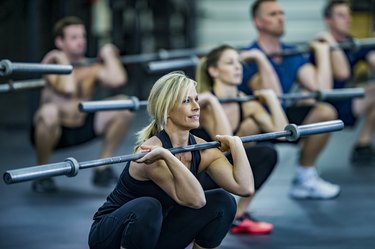
A little soreness following a heavy squat workout is a part of training. How else would you know you're building that essential lower-body and core strength? But lingering back pain or any sharp pain in your back post-squatting lets you know that something's off and that it may be time to see a health care professional.
Warning
If you feel lower back pain while squatting (especially if you're squatting with a loaded barbell), stop the exercise. A medical expert can help you find the best plan of action for you.
Video of the Day
Fix Your Squat Form
Squatting with proper form, especially if you're doing it with a barbell or dumbbells, is crucial to keeping your back safe and healthy. Done right, a squat won't compromise the integrity of your spine or muscles of your back. But squatting uses more than 200 muscles across your body, according to the National Academy of Sports Medicine (NASM), so there's a lot to keep in mind.
Video of the Day
To make sure you're squatting perfectly, follow these steps. Bonus points for asking a trainer at the gym to check your form or giving yourself a once-over in the mirror.
- Begin with your feet shoulder-width distance apart, heels rooted into the ground. Think about being heavy in your heels.
- Push your hips back and lower your rear down as if you're sitting into a chair. Your thighs should be parallel to or slightly below parallel to the ground.
- Keep your chest proud and upright, eyes forward, chin lifted and shoulders down. Your back should stay straight.
- Reverse out of the motion by driving your hips forward and maintaining your upper-body posture.
If your knees are caving in or you struggle to maintain a flat back, you may have potential muscular imbalances that could be throwing off your form and/or causing your pain, according to NASM. A professional trainer can help you correct those imbalances (and your form!) to limit the discomfort.
Read more: 12 Essential Squat Variations to Try
Squat Strategically
If your squat form looks correct, yet you still feel lower back pain, you may not be properly engaging your core, according to NASM. Your abs play a key stabilizing role in this exercise. Consciously tightening your core as you squat will keep you from arching your back, a common squat-related mistake that can lead to injury.
Or squat facing a wall (toes touching the wall). This can help you not leaning too far forward, which can hurt your lower back, and keep your knees behind the toes to make sure they're driving back with the glutes.
It's important to program your squats wisely, too. Consider the lifts and exercises you perform in the days preceding and following your squats. For instance, if you're lifting super heavy, avoid performing deadlifts and squats back-to-back (or even the same day), as too much attention on your lower body can lead to fatigue. Or, if your job involves heavy physical labor, schedule your squats for the weekend.
Read more: Join Our 30-Day Squat Challenge